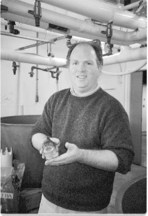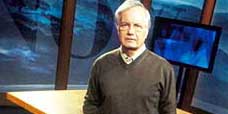
Philippines RPCV Ed Seidel is new Director at Department of Marine Resources Aquarium
Ed Seidel: New Director at Department of Marine Resources Aquarium
Lisa Kristoff
Caption: Ed Seidel, new Director of the Maine Department of Marine Resources Aquarium in West Boothbay Harbor. (Photo Lisa Kristoff)
"I am very excited and happy to be back in Maine, and to be a part of the Department of Marine Resources Aquarium. It is amazing to have so many resources right here on McKown Point, and have so many individuals with numerous areas of expertise - at DMR and Bigelow." -- Ed Seidel.
November 15 was native Mainer Ed Seidel's first official day asthe new Department of Marine Resources Aquarium Director. A life-long enthusiast of science, biology, and art, Seidel always expected to be involved in research. His journey from researcher to aquaristhas spanned two decades. His passion for marine life and the preservation of its environment is what has kept him on a path that eventuallyled him to West Boothbay Harbor.
After completing his undergraduate work at Middlebury College in Vermont, Seidel signed on for a two-year stint in the Peace Corps. He spent the next 24 months in the Philippines on Guimaras Island, doing marine fisheries work. It was here that his interest and concern for aquatic life and their habitat would evolve and grow.
On the island, Seidel's assignment was to reduce the amount of dynamite fishing on the Island. He approached the problem by finding supplemental income that would generate projects for the fishermen that were not so destructive. Fishermen on the island would go out onto the water with dynamite or homemade bombs - converted rice-farming fertilizer. When schools of fish were spied, they would throw the bombs and literally blow the fish out of the water, then scoop them up in a net.
Said Seidel, "The fishermen did catch lots of fish, but, they didn't like dynamite fishing. Many lost arms and hands when the handmade bombs went off too soon. They only did it to make money and keep their families fed, so there was much incentive to try something new - and help preserve what remained of the underwater environment. Unfortunately, in addition to fish, these areas also contain a variety of corals that cannot survive the shockwaves. Huge desolate areas that were formerly vibrant coral reef communities were the result. Destruction of the reefs then destroyed the habitat of the fish, thereby reducing the possibility of future generations of fish. Additionally, the shockwaves of that magnitude will alter the bone structure and internal organs of any surviving fish. They tend to decompose very quickly."
Seidel and the fishermen tried a variety of alternatives, but found seaweed farming was the idea that worked the best. Carrageenan is derived from seaweed and is used in toothpaste, beer, and ice cream, as well as many other products. This turned out to be something the men could do to supplement their income without a great deal of extra work.
During his time on Guimaras Island, he began applying to colleges for his graduate work. As fate would have it, Seidel's grandmother, a marine biologist of the 1920s, sent him an article she had written for National Geographic on the Monterey Bay Aquarium in California, one of the largest in the United States.
"I read this article over and over," said Seidel, "Some of the information covered jobs at the aquarium and how it was a fusion of biology and art. I was blown away. I had never thought of a career in aquariums, but I went out there and was blown away again."
Once on site, Seidel was drawn to its beauty, diversity, and its mission: to inspire conservation of the world's oceans. He began his work there in a variety of the education programs. Some of these programs included the Mobile Aquarium that was taken to schools and migrant labor camps. After two years he decided to increase his knowledge of the animals within the depths. He eventually continued his studies at Moss Landing Marine Labs in Moss Landing, California, on Monterey Bay.
At Moss Landing, a great deal of research was done utilizing submersibles. A submersible is a manned submarine-type of research vehicle. Depending on the model, they travel to depths ranging from 1,000 to 3,300 feet. Some are suitable for tourism usage.
"The deepest area of Monterey Bay is two miles deep and there are all sorts of wild, crazy-looking animals down there," recalled Seidel. "And within the Bay is a canyon equivalent to the size of the Grand Canyon." Because the Monterey Bay Aquarium is a regional aquarium, one of its functions is to exhibit organisms found in the Bay. As Seidel was beginning his graduate work, the Aquarium began work developing a deep sea exhibit. The final exhibit, named the "Mysteries of the Deep," is the largest of its kind and opened in 1998. Within the 7,000 square foot exhibit, 45 species were included - 25 of which had never been seen before. Some of the new species were the Squat Lobster (actually a crab), Mystery Mollusk, Cat Shark and Eel Pout. Other species include the Predatory Tunicate which resembles a transparent Venus Fly Trap, and the Hagfish, a member of the eel family that eats its prey from the inside out!
Most of Seidel's work employed the use of ROVs (Remotely Operated Vehicles), a robot the size of a Volkswagen Beetle, with arms, and research equipment. ROVs were the "tool of choice" because the canyon in the Bay was too deep for a submersible. Seidel's job included keeping the creatures from the sea floor and above -- the stars of the exhibit -- alive after capture.
Being a Mainer born and bred, Seidel would spend vacation time in Camden and exploring other areas of the state. It was during one such vacation that he heard about the aquarium at DMR. Seidel, his wife, Lisa Katz, and his eldest son, Theo, paid a visit to the aquarium. And it was during that visit he met DMR Education Director and Burnt Island Lighthouse Keeper Elaine Jones. In 2002, Jones contacted Seidel to enlist his assistance in creating a jellyfish exhibit at DMR, and assist he did. The Monterey Bay Aquarium was the donor of two jellyfish tanks. That summer, Seidel and his family, now joined by younger son, Toby, stayed on Burnt Island while he helped Jones install that exhibit.
Shortly after the Seidels' return to Monterey Bay, Jones and Dawn Grover went to California to obtain training in jellyfish exhibits and observe an aquarium on a much larger scale.
Following the journey, Jones and Seidel kept in touch via email. And, when a new aquarium director had to be found, Jones seized the moment and contacted Seidel - a man very interested in returning to Maine on a permanent basis.
Said Jones, "I am thrilled to have Ed Seidel on board as the new Aquarium Director. Ed brings to the DMR knowledge and experience, and is a highly-regarded aquarist and curator from the best aquarium in the world. He will take the Marine Resources Aquarium to a new level as a result of his passion and skills."
Some of the new levels Seidel is working on now include the acquisition of an ROV for the months the aquarium is in operation. Through Seidel's efforts, the President of the manufacturing company Video Ray, Inc. is donating the vehicle for the 2005 season. The full plan is to take visitors to the DMR wharf and conduct a program on ROVs, let them navigate it and observe the aquatic life. The images from the ROV will be projected on an on-land monitor. Children, Seidel said, are particularly adept at using the equipment.
Another idea is patterned after a program in Monterey, California and Rhode Island. In both locations, high school students construct their own ROV culminating in a state-wide competition. The competition brings students and teachers into a mutual learning experience. Challenges during the competition might include navigating through an underwater maze, pick up a "lost" piece of submerged equipment, etc. Students know in advance what the specific challenges will be.
"The students get really involved. They love the challenge of the technology itself, and the competition. I have seen freshmen work on different ROVs over their four-year period of high school and you can see incredible leaps in their ability and sophistication. Some students have gone on and done some incredible things in engineering."
Other ideas: a permanent ROV for the region; an ROV outreach program at the Town Landing, near Pier 8; a live plankton display - a type of "show and tell" -- from which live images would be projected onto a wall at DMR; and the acquisition of a "spyball," a device placed in tanks and operated by a joystick enabling visitors to see the various species up close and personal. Some pretty exciting ideas are certainly in the offing for the region, but, what Seidel really wants to accomplish is to broaden the public's awareness of just what kinds of work are going on at DMR.
"I really want to bring the Department of Marine Resources and the people that work here into the community," said Seidel, "I want to let them see what is happening here. The plankton lab would be a perfect example of that. There is a great deal of water quality monitoring that goes on here for red tides. We could share the findings with the public in an entirely different forum utilizing a high-powered microscope. And that is just the beginning."
With all of these exciting expansion ideas beginning to take shape, Seidel is also interested in creating a community-based volunteer program at the aquarium. After witnessing the success of the program at the Monterey Bay facility, Seidel feels it is an excellent way to bring the community and the aquarium together. Volunteers attended classes that were the equivalent of college credit courses. They learned to identify the creatures and about the vital components of their habitat, as well as the ins and outs of the various exhibits and exhibit equipment.
"The volunteers made the experience really special," said Seidel. "In today's society, people just don't get much human interaction. They (volunteers) really enjoyed the experience; relating to the children and families and sharing their knowledge. Some volunteers did scuba diving, ran the touch tanks and the ROV displays. I'm sure we could get a great volunteer program off the ground here as well. There are a great many well-educated, civic-minded people here that I am sure would make terrific, specialized volunteers."
To become part of the expansion of the DMR Aquarium on a volunteer level, contact Ed Seidel at 633-9542 or by email: HYPERLINK "mailto:edward.seidel@maine.gov." edward.seidel@ maine.gov.
To view ROVs visit the Video Ray website: HYPERLINK "http://www.videoray.com" www.videoray.com.
To find out more about the Department of Marine Resources or the Aquarium, visit DMR's website, www.state.me.us/dmr/.










